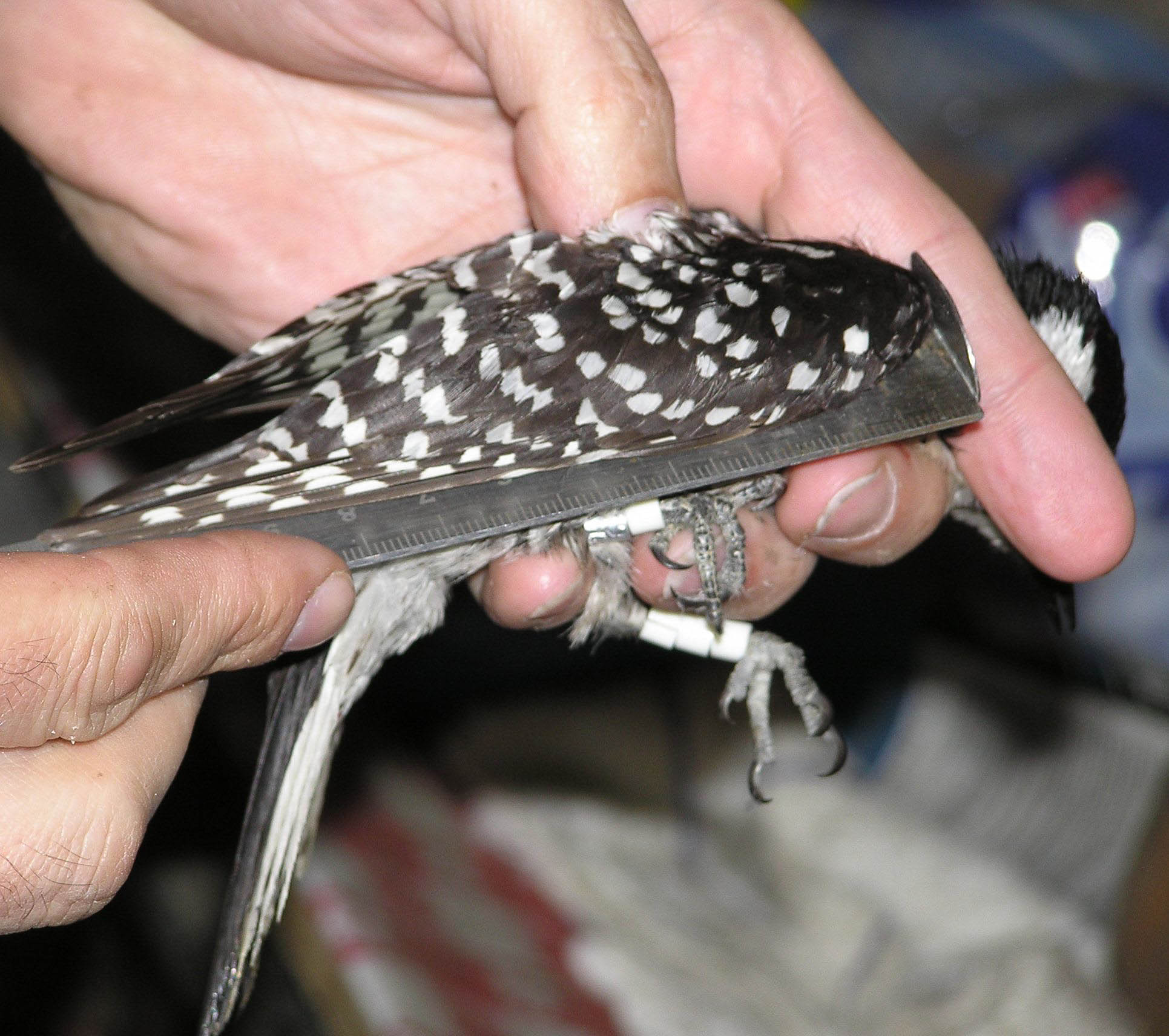Success of red-cockaded woodpecker translocations in Virginia
Azalea back to Potomac River
September 12, 2009Azalea returns to Little Wicomico River
September 13, 2009
Written by Michael Wilson & Bryan Watts
September 12, 2009
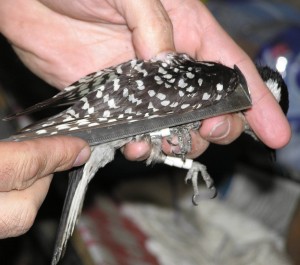
Bryan Watts uses a wing ruler to measure the wing chord of a male bird translocated to Piney Grove. Photo by Bart Paxton.
By 1970, drastic losses in the required habitat of the red-cockaded woodpecker had reduced populations below 1% of their historical numbers. Red-cockaded woodpeckers were recognized as being endangered throughout their range and subsequently this species received federal protection with the passage of the Endangered Species Act of 1973. By 1990, most of the largest remaining populations were stabilized from further decline but many of the smaller, isolated populations were faced with a long road of habitat restoration and management to prevent their extirpation.
The history of decline for red-cockaded woodpeckers in Virginia followed a course that was similar to other portions of its range. Despite being listed under the Endangered Species Act, more than half of the known Virginia population was lost between 1977 and 1980 from deforestation of inhabited areas. By 2002, only 3 of the original 23 breeding groups detected in 1977 were still remaining. These 3 remaining groups were located within an old-growth loblolly pine forest in Sussex County that was purchased by Hancock Timber and subsequently by The Nature Conservancy. This property was named the Piney Grove Preserve, and now represents the northernmost population of red-cockaded woodpeckers throughout their range.
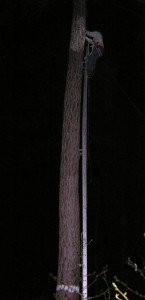
Bryan Watts uses Swedish climbing ladders to place a translocated bird into an artificial cavity in a loblolly pine at 2:00 AM. The bird was released into its new habitat at Piney Grove Preserve at dawn. Photo by Bart Paxton.
Management of red-cockaded woodpeckers at the Piney Grove Preserve includes conventional methods of timber management, prescribed fire, artificial cavity provisioning, and cavity competitor control. It was also realized that translocation of new individual woodpeckers into the Piney Grove population would be needed to bolster the population. Translocation of individual woodpeckers from donor populations is a preferred management tool designed to expedite the recovery of small, at risk, populations of red-cockaded woodpeckers. Translocation is essentially a method of assisted immigration where young-of-the-year birds are captured from donor populations and moved to new management areas around the time of typical dispersal from the natal site. Donor populations are typically identified as having more than 250 breeding pairs that produce a surplus of dispersing birds such that planned removal is considered to have no deleterious effects on that population.
Between 2001 and 2005, 25 woodpeckers were translocated from other populations into the Piney Grove Preserve. Twenty-one of the birds moved to Virginia originated from the Carolina Sandhills National Wildlife Refuge in South Carolina, 3 birds were transported from Gates County, North Carolina, and 1 lone male that was isolated from any other woodpeckers for many years was moved from Southhampton County, Virginia. All birds within the Piney Grove population, whether natal or translocated, are color banded to allow individual recognition so the history of each bird may be tracked from our population surveys.
Considerable effort and coordination is required to successfully translocate woodpeckers between populations. This begins with preparation of recruitment clusters or recipient sites within Piney Grove. Sites believed to be suitable for breeding pairs are prepared by inserting artificial nest cavities into suitable trees. Four cavities are provided per cluster. Biologists working with the donor population must select young birds from breeding clusters for removal. A translocation team is then sent to the site to remove target birds from cavities just after roosting at dusk. These birds are transported in individual holding boxes through the night and placed in their artificial cavities before dawn so that they may be released into their new habitat. A male and female are released together in each recruitment cluster in the hope that they will form a breeding pair. In most years, 3 pairs were translocated from the refuge in South Carolina to Virginia.
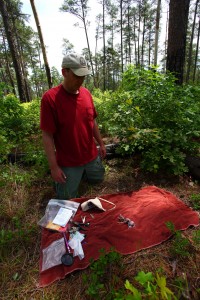
Michael Wilson prepares equipment for banding a brood of 3 red-cockaded woodpecker chicks (center of towel). Photo by Bryan Watts.
The translocation program has proven to be one of the most important management tools aiding the recovery of the species in Virginia. Six of the 25 translocated birds have become breeders and have contributed 30 of the total 69 fledglings produced at the Preserve from 2003 through 2009. In 2009, translocated birds were responsible for producing 6 of a one-year record high 15 fledges.
The momentum provided by the translocation program is made apparent by the addition of 5 new potential breeding groups and an increase in the overwintering population from 26 to 41 individuals since 2003. Translocated birds have also been responsible for 7 second generation woodpeckers produced from the successful breeding of their direct descendants. These breeding birds have presumably contributed to the genetic diversity within the Piney Grove population an ongoing conern for small isolated populations.
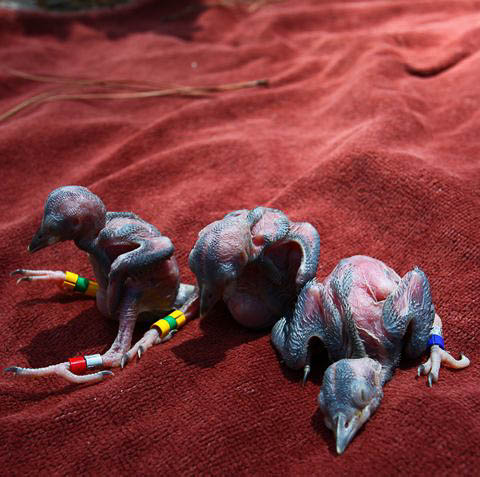
This brood of red-cockaded woodpeckers hatched in 2009 is from the pairing of a translocated male and a native Virginia female. The male of this breeding pair has successfully fledged 6 birds since 2007. The color band combinations allow for resight identification. Photo by Bryan Watts.
The Piney Grove population continues to grow and is nearing saturation for the 1,500 acre site. There are no translocations scheduled for Piney Grove in the near future. However, translocation will likely remain an integral part of the recovery of this species in Virgnia when new lands purchased by The Nature Conservancy for the red-cockaded woodpecker are made available through habitat management.
Project sponsored by The Center for Conservation Biology (CCB), the Virginia Department of Game & Inland Fisheries (VDGIF), the U.S. Fish & Wildlife Service (USFWS), and The Nature Conservancy (TNC).

